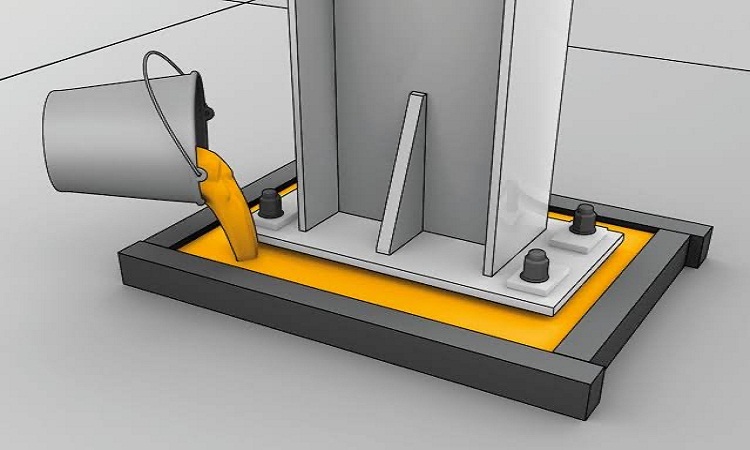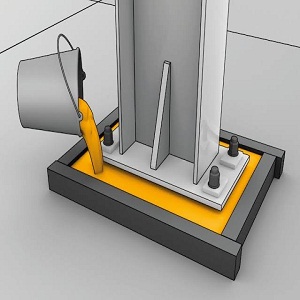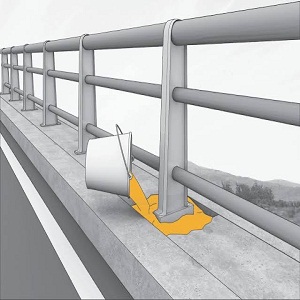Engineering grout is a material that has properties on non-shrink, free flow, high early strength for bolt pocket, and base plate of machines to ensure firm and vibration-free equipment.
Engineering grout is composite material generally consisting of water, cement, and sand. Engineering grout is normally utilized for filling voids under machines or other structural elements, sealing joints and openings in surfaces, and reinforcing existing structures.
Types of Engineering Grout
There two main types of grout i.e.
- Cementitious grout
- Epoxy-based grout
Cementitious grout
The cementitious grout is based on processed cement containing fillers & additives. It is used for all types of static, dynamic, and rotary equipment.
Cementitious grout is formed by mixing cement powder with water in which the ratio of cement of water is more or less similar to that of concrete. Owing to the relatively high water content, the mixing of cement with water produces a fluid suspension that can be poured under base plates or into holes. Setting and hardening are the important processes that affect the performance of cement grout. Moreover, grout permeability is versatile in applying filling voids and gaps in structures.
Epoxy-based grout
The epoxy-based grout is strong, water and chemical resistant. Epoxy grout is generally more expensive than cementitious. Epoxy grout is used where high compressive strength, high tensile strength, and chemical resistance are required like heavy-duty rails, machinery, compressor, dowel bars, etc.
Epoxy-based grout consists of epoxy resin, epoxy hardener, and sand or aggregates. In fact, there are different types of resin used in the construction industry like epoxy, polyester, polyurethane, etc. tough epoxy grout appears to imply the presence of cement material by its name, and epoxy hardener serves to initiate the hardening process of epoxy grout. It is normally utilized to repair hairline cracks and cavities in concrete structures and be adopted as a primer or bonding agent.
Main Properties of Engineering Grout
- Free flow
- Easy to use
- Non-shrink
- High strength/Ultra high strength
- High early strength
- Temperature resistance
- High final strength
- Non-corrosive
- Non-flammable, non-toxic
- Excellent bond to concrete
- Impact and vibration resistance
- No segregation or no bleeding
Examples of Engineering Grouting Needs
The table given below is designed to be read from left to right. It describes what are the necessary properties that grouts need to exhibit when applied in a particular way to fulfill a function in various circumstances to fill different requirements.
Non-shrink & durable properties are essential to all the cases described below. When the method of application is utilizing an injection system, then it is probable that some pressure of pumping would be necessary.
| Need/Use | Grout Function | Delivery Method | Essential Properties |
| Machinery/equipment Base plate grouting | Load transfer leveling | Pouring Pumping | Compressive strength Impact resistance |
| Load bearing elements Column/beams Bearing pads | Leveling load transfer | Pouring Pumping | Compressive strength |
| Post-tensioned cable Ducts | Stress retention Corrosion Protection | Pumping | Compressive strength Non-bleeding |
| Cracks in structures Fissures in rock | Waterproofing grout support | Pumping | Compressive strength High bond strength |
| Voids around tunnel Linings, pipes, or submerged elements | Waterproofing Consolidation | Pumping Injection | Cohesive below water Compressive strength |
| Permeable and unstable soils | Waterproofing Consolidation | Injection | Low viscosity Compressive strength Water displacing |
| Anchors and fixings | Load transfer | Pouring, pumping Injection Capsule insertion | Compressive strength Rapid setting |
Checklist before Application of Engineering Grout
Pre Application Checklist:
Material Requirement:
- Estimated quantity of grout
- Proper shuttering/formwork and mould release agents
- Grout mixing equipment
- Pouring/mixing equipment and vessel
- Manpower
- Mixing water
- Steel rod for mixing of grouts in a vessel
Surface Preparation:
Remove all loose particles, dust, debris, oil, paints, etc from the grouting pocket. Use an air blower or vacuum cleaner to blow out all finer particles. The shuttering should be leakproof.
Mixing of Grouts:
- Mechanical mixing is a must for the mixing grout. Use paddle mixer or drum type tilting concrete mixer.
- Charge 80% of mixing water (as per the given water/powder ratio) to the mixer.
- Start mixer, start the addition of dry grout powder.
- Add 40-50 number of clean and water-soaked 100mm aggregates stones.
- Mix for 3-5 minutes.
- Add balance 20% of mixing water and mix for another 2-3 minutes.
- Pour mixed grout through the steel wire mesh into grout placing or pouring equipment/vessel.
- Remove wire mesh along with 100mm aggregates stones.
- Use steel rod for continuous mixing of wet grout in a placing vessel.
Placing of Grouts:
- For large & continuous pour using placing/pour vessel, the flap valve is provided to vessel for flow of grouts.
- Ensure crane is accessible for transportation of placing vessel from mixer to grouting place.
- For small jobs use the bucket for placing grout.
Curing of the Exposed Grouts:
When the grout is tough dry i.e. after 3-4 hours of placing cover the exposed grout area by wet hessian & later on by water Ponding. Remove the shuttering or formwork after 1 day of curing of grouts.





